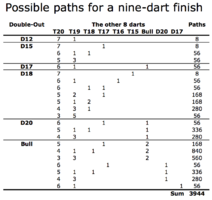Hi Chris. Looking at your chart, I think I understand it (except, possibly, for the specific point value of 'Bull').
It describes 9-dart finishes, so nine darts are thrown totaling 501 points.
Double-Out means the last dart lands in a region with doubled points.
The path counts suggest that you mean
permutations instead of combinations. In combinations, order does not matter. When different orderings are counted separately, we call them permutations.
For example, the first row lists eight paths to reach 501 points when the last dart lands in the region for 12-doubled (D12). Seven darts must land in 20-tripled (T20) and one dart must land in 19-tripled (T19). What I just listed is a combination, so there is only one combination of 9 dart throws scoring 501 points when one of them scores 24 (D12).
Here are the eight permutations (i.e., different throwing orders possible), when the last throw scores 24:
T19 , T20 , T20 , T20 , T20 , T20 , T20 , T20 , D12
T20 , T19 , T20 , T20 , T20 , T20 , T20 , T20 , D12
T20 , T20 , T19 , T20 , T20 , T20 , T20 , T20 , D12
T20 , T20 , T20 , T19 , T20 , T20 , T20 , T20 , D12
T20 , T20 , T20 , T20 , T19 , T20 , T20 , T20 , D12
T20 , T20 , T20 , T20 , T20 , T19 , T20 , T20 , D12
T20 , T20 , T20 , T20 , T20 , T20 , T19 , T20 , D12
T20 , T20 , T20 , T20 , T20 , T20 , T20 , T19 , D12
Let me know, if I've misunderstood anything. Does your dart board have an inner bullseye (25 points) and outer bullseye (50 points)? If Bull=50 in the chart, then it doesn't seem to be doubled in the last throw.

[imath]\;[/imath]


